If you consider yourself a bon vivant, you are well aware of the esteemed reputation of Korean Food on the global culinary stage. It encompasses much more than the beloved Kimchi. Similar to other Asian cuisines, Korean Food requires an acquired taste, a journey worth embarking upon. This cuisine has evolved over time, shaped by social and political changes. Unlike Western dining traditions, Korean food consists of main and side dishes. Traditional Korean dishes are categorized into five colors – green, red, yellow, white, and black – each representing a direction, a natural element, and a health benefit.
For those eager to explore the wonders of Korean Cuisine but unsure of where to begin, here is a comprehensive list of all the Korean dishes that should be on your culinary bucket list.
Korean Food Extravaganza: Must-Try Dishes
Allow this Korean food compendium to guide you through the gastronomic wonders of the Korean culinary landscape. Beyond the customary Kimchi and Korean BBQ, there is a vast array of dishes in Korean cuisine that every food enthusiast should acquaint themselves with.
- Bibimbap
- Japchae
- Samgyeopsal
- Kimchi
- Haemul Pajeon
- Kimbap/Gimbap
- Sundubu Jjigae
- Tteokbokki
- Seolleongtang
- Patbingsu
- Hangover Stew
- Kongguksu
- Jjajangmyeon
- Chimaek
- Soy Sauce Crab
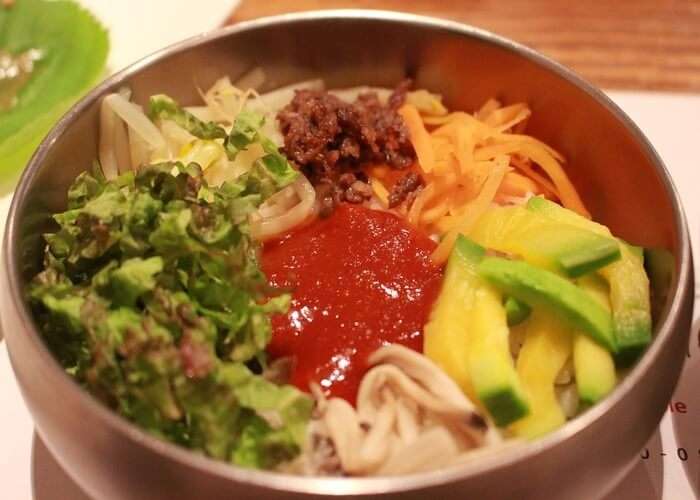
1. Bibimbap (Scrumptious Rice Bowl)
For those who find solace in the delightful simplicity of food bowls, Bibimbap is guaranteed to satiate and comfort. This delectable dish is a medley of rice, vegetables, beef, gochujang (spicy chili paste), and a perfectly fried egg seasoned with soy sauce and sesame seeds.
Originally a dish fit for royalty, Bibimbap has evolved throughout the years to become a beloved staple for lunch among Korean cuisine advocates.

2. Japchae (Tantalizing Stir-Fried Glass Noodles)
Unarguably considered Korea’s favorite noodle dish, Japchae is a delectable combination of glass noodles delicately sautéed in sesame oil with beef, mushrooms, and an assortment of vibrant vegetables. These translucent, slender noodles are made from sweet potatoes.
Unlike other Asian noodle dishes, where the norm is to enjoy them in a soupy fashion, Koreans consider it impolite to eat with the bowl too close to the mouth. Therefore, they indulge in these flavorful noodles using a spoon along with elegant metal chopsticks.
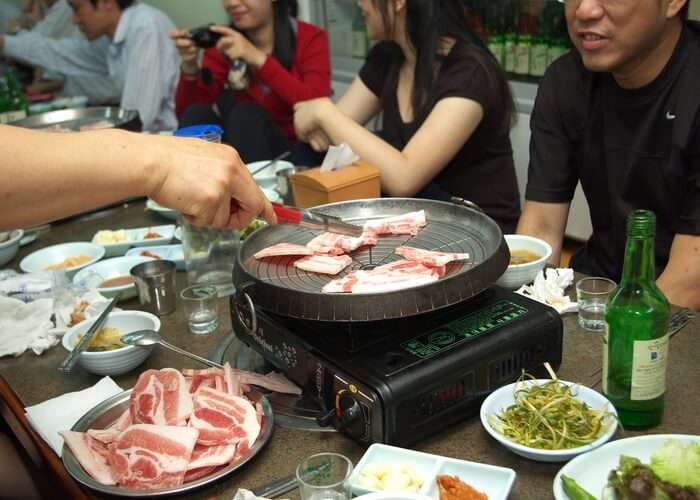
3. Korean Pork BBQ (Samgyeopsal)
The Korean people have a certain fondness for pork, and they express it through their unique style of BBQ called Samgyeopsal. If you happen to be a non-vegetarian who enjoys pork meat, then you absolutely must experience the delight of Samgyeopsal. This dish consists of thick slices of pork belly grilled on your table without any marination. The succulent strips are then dipped in a savory seasoning made with sesame oil, and wrapped in a crisp lettuce leaf along with a strip of garlic and onion. Samgyeopsal is a highly popular meal in Korean cuisine.

Recommended Reading: 26 Enchanting Winter Destinations in Korea That Will Capture Your Heart
4. Spicy Fermented Vegetables (Kimchi)
When it comes to Korean food, the first thing that typically comes to mind is Kimchi. Considered a staple in Korean cuisine, Kimchi offers an ideal introduction to the flavors of this rich culinary tradition. Imagine a spicy and crunchy salad composed of fermented vegetables, with cabbage as its primary ingredient. Not only does it possess high nutritional value and fiber content, but it is also low in calories. No Korean meal is complete without this delightful side dish.
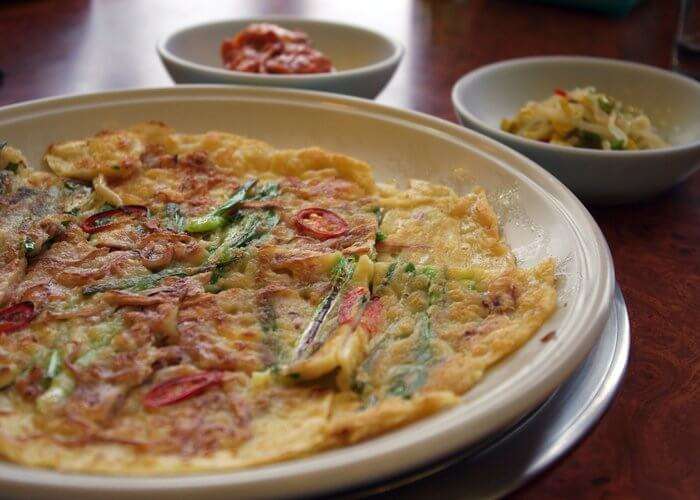
5. Seafood Vegetable Pancake (Haemul Pajeon)
Calling all seafood enthusiasts! If you happen to love seafood, then Haemul Pajeon is a dish that deserves a spot on your culinary bucket list. Crispy on the outside, this pancake is crafted from a rice and egg batter mixed with an assortment of fresh seafood and green onions. Commonly used seafood ingredients include shellfish, oysters, shrimp, and squid. It is customary to pair this savory Korean pancake dish with Korean Rice Wine, known as Makgeolli. However, be cautious, as despite its sweet taste, Makgeolli is a potent alcoholic beverage.
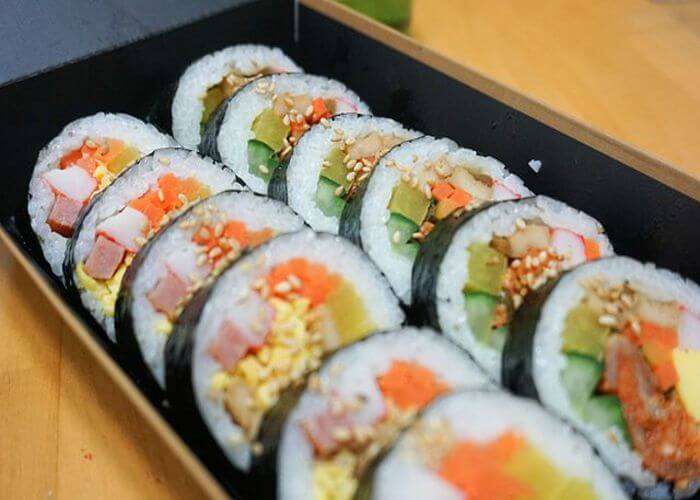
6. Korean-Style Sushi (Kimbap/Gimbap)
Gimbap, also known as Kimbap, is a popular grab-and-go street food in Korea that bears a striking resemblance to Japanese sushi rolls. These delightful creations are almost too visually appealing to consume. Gimbap is prepared using sushi rice, which is combined with meat, spinach, and stir-fried vegetables, and wrapped in a sheet of seaweed. The resulting roll is then sliced into bite-sized pieces and served with a side of kimchi. The next time you find yourself in Seoul, make sure to indulge in this exquisite Korean culinary delight.
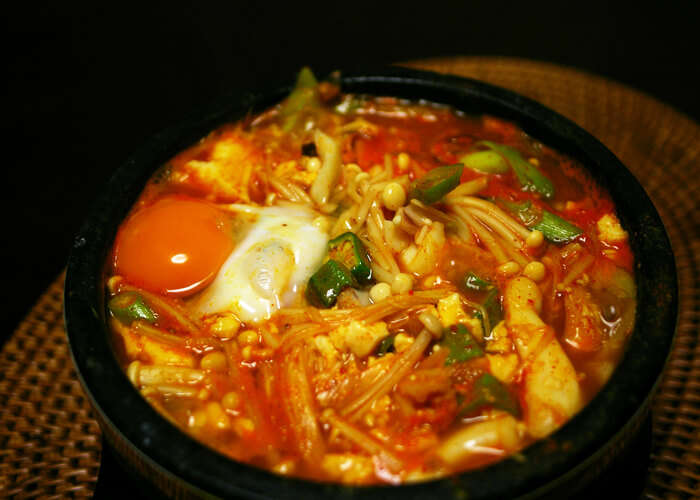
7. Soft Tofu Stew: A Spectrum of Flavors
Prepare to embark on a culinary journey with Soft Tofu Stew. This beloved Korean dish combines tofu, vegetables, meat, seafood, and chili paste, all crowned with a raw egg. Served in a generously-sized stone bowl alongside rice and kimchi, this stew is a true feast of unique flavors.
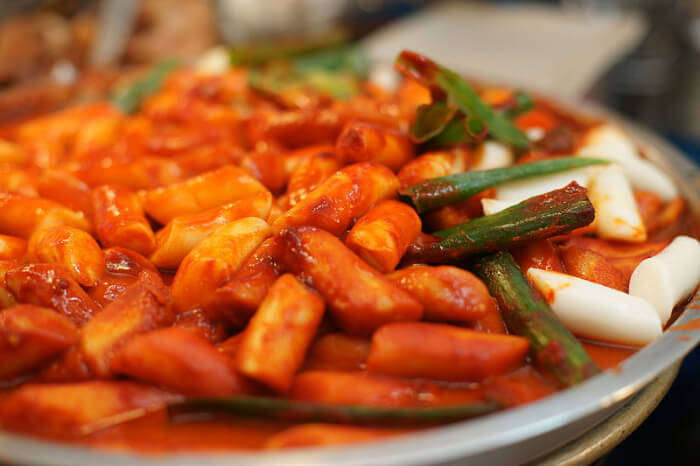
With various regional variations, this steaming hot stew promises delightful surprises, teasing your taste buds with its unexpected combinations.
8. Spicy Red Rice Cake: Tteokbokki
Tteokbokki, a beloved Korean street food in Seoul, features sweet and chewy rice cakes harmoniously mingled with fish cakes. Stirred in a special sauce made from chili paste and soybean paste, these flavorsome delicacies are garnished with scallions. A fiery treat for lovers of spicy cuisine, Tteokbokki is an absolute must-try.
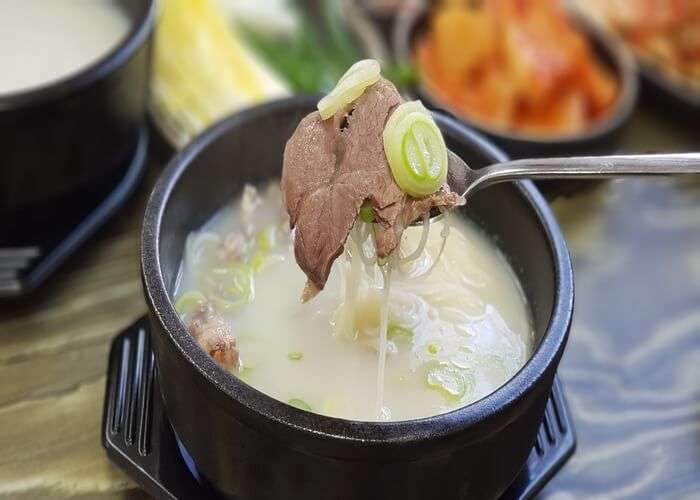
9. Ox Bone Soup: Seolleongtang
Rejoice, for Seolleongtang is the Korean counterpart to our beloved Indian ‘Kharode ka Soup.’ A cherished dish in Korean households, this winter soup is meticulously prepared by simmering ox bones and beef bones for hours. This protein-rich, milky-white soup is then seasoned with salt, pepper, garlic, and scallions. Indulging in a bowl of Seolleongtang on chilly winter days is pure bliss.
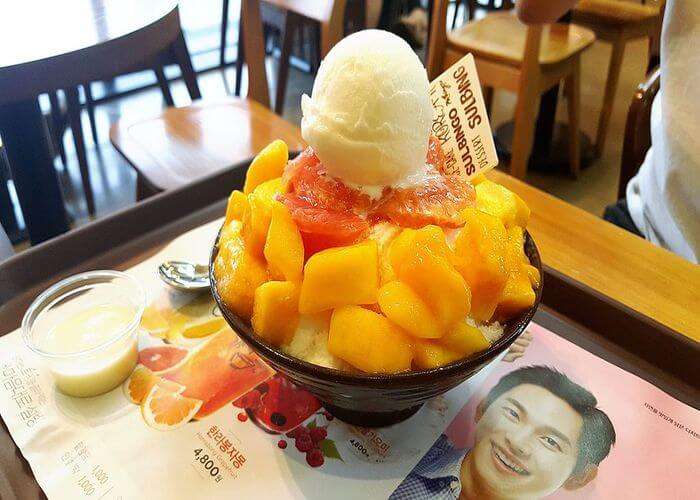
10. The Majestic Patbingsu
No list of delectable Korean treats would be complete without mentioning Patbingsu. A quintessential dessert in Korea, this heavenly delight features a mountain of finely shaved ice and a drizzle of condensed milk. Adorned with a medley of chopped fruits and red beans, Patbingsu satisfies every sugar lover’s cravings.
Korean tradition dictates that desserts are best enjoyed together, served in a generous communal bowl. So, fear not if presented with an enormous serving of Patbingsu at a restaurant. However, with a dessert this irresistible, you might find it hard to share with others.

11. The Cure-All Hangover Stew
In South Korea, the hangover culture is just as developed as its drinking culture. There are a variety of stews specifically prepared to be consumed either before or after drinking. These stews are made with beef broth, along with ingredients like cabbage, radish, bean sprouts, spices, and other flavorful additions.
12. Kongguksu
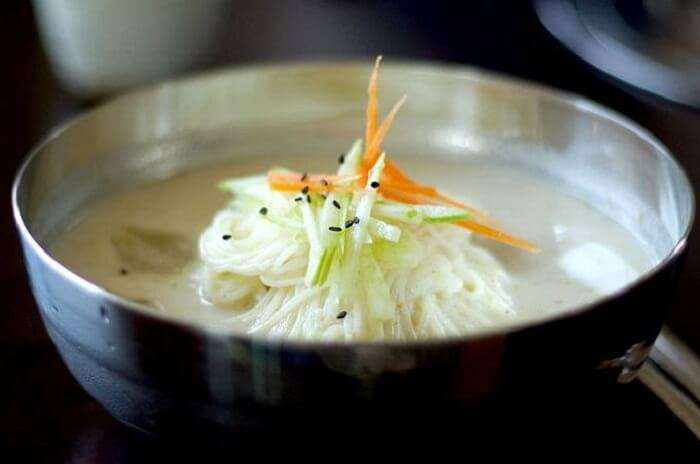
Kongguksu is a dish enjoyed during the summer season, although it may not be to everyone’s taste. This textured noodle dish features a delicate hint of beans and is not only highly nutritious but also a vegetarian option in Korean cuisine. If you follow a vegetarian diet, Kongguksu is a must-try when visiting Korea.
13. Jjajangmyeon
Originally originating from China, Jjajangmyeon has become a beloved dish in Korea, with their own unique and more flavorful version. While it may not be the most renowned Korean food, Koreans indulge in Jjajangmyeon at least once a week. In fact, they’re so passionate about this dish that there are delivery shops dedicated to it.

14. Chimaek
Chimaek is a delightful combination of two simple foods – chicken and beer – transformed into a delicious dish. Koreans love this dish so much that they prefer it over just chicken or beer on its own. If you’re in search of something more exciting to satisfy your taste buds, Chimaek is the perfect choice.
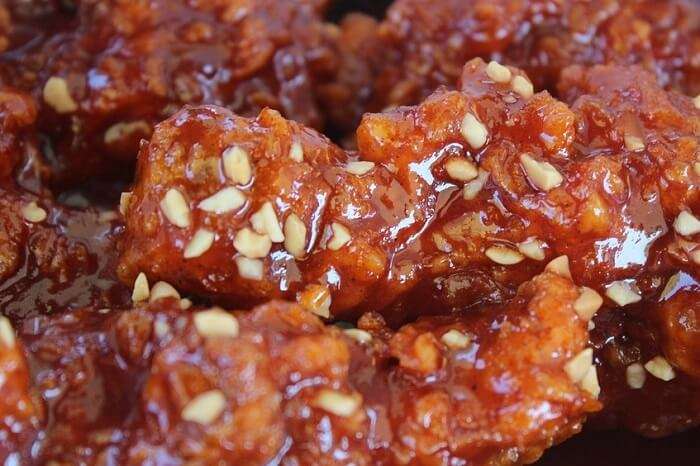
15. Soy Sauce Crab
Soy Sauce Crab, or ganjang gejang, is a highly addictive dish for Koreans. It has a tangy and slightly bitter taste and is typically enjoyed cold rather than hot. If you’re an adventurous eater, this dish is a must-try as its unique flavor can be quite surprising, especially for first-timers. It is gaining popularity and carving its own niche in the seafood market.

Korean Cuisine is an absolute must for those eager to embark on exciting gastronomic journeys. Discover new culinary horizons with an unforgettable escapade through a vacation tailored by Fred and Fuzzys. The flavors of Korean food are intense and a true delight for your taste buds. While not everyone may immediately succumb to its allure, there are those who will passionately embrace it with their whole being. As previously stated, Korean cuisine requires an open mind.
Please be aware that Fred and Fuzzys does not claim ownership of any images featured on our blog, unless explicitly stated otherwise. All visual content is protected by copyright and belongs to its respective owners. We strive to provide appropriate attribution by linking back to the original sources whenever feasible. If you are the rightful owner of any images and do not wish for them to be displayed on the Fred and Fuzzys platform, kindly reach out to us and we will promptly remove them. Our commitment lies in giving proper recognition to the original authors, artists, or photographers.
It is important to note that any information disseminated by Fredandfuzzys.com in any form of content is not intended to replace professional medical advice. It is crucial to seek guidance from a trusted medical expert before taking any action.
Embark on a culinary journey through South Korea with a selection of frequently asked questions about traditional Korean food:
What comprises traditional Korean cuisine?
Discover the wonders of South Korean gastronomy with a variety of traditional recipes that are a must-try:
– Bibimbap
– Korean dumplings
– Stir-fried Korean noodles
– Kimchi stew
– Korean Beef Barbecue Bulgogi


